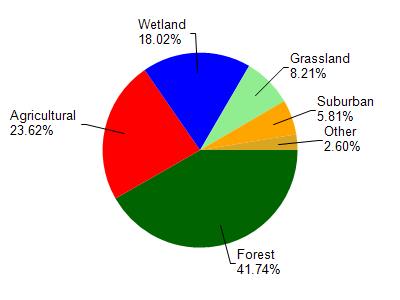Portage
No
No
No
Fish and Aquatic Life
Overview
Jordan Pond is a hard water impoundment on the Plover River five miles northeast of Stevens Point. The river is navigable both above and below the pond and is a popular canoe route. Silt is the predominant bottom type at the lower end, while sand and gravel areas are more prevalent near the upper end. The use of the dam for generating electricity has been discontinued. Northern pike, smallmouth bass, perch, and pumpkinseed are the only game species present. Black bullheads, carp, white suckers, and redhorse are more dominant and may create a problem. Developments consist of just two houses. Also present is a large county park. Facilities include picnic area, beach, boat launching ramp), camping areas with electricity, and a small wildlife sanctuary containing, ducks and geese and a deer pen. Muskrats, deer, and otter have been reported in the vicinity of the pond, and an osprey was observed. The pond and park area are very scenic and a big attraction for campers and vacationers. There is no hunting or firearms allowed on Dark lands.
Source: 1972, Surface Water Resources of Portage County Jordan Pond, T24N, R8E, Section 12, Surface Acres-83.0, S.D.F.- 2.16, Maximum Depth-10 feet
Date 1972
Author Aquatic Biologist
General Condition
Jordon Pond (WBIC 1403600) was assessed during the 2018 listing cycle; new total phosphorus sample data were clearly below the 2018 WisCALM listing thresholds for the Recreation use and the Fish and Aquatic Life use. This water was meeting these designated uses and was not considered impaired.
Date 2017
Author Ashley Beranek
Condition
Wisconsin has over 84,000 miles of streams, 15,000 lakes and milllions of acres of wetlands. Assessing the condition of this vast amount of water is challenging. The state's water monitoring program uses a media-based, cross-program approach to analyze water condition. An updated monitoring strategy (2015-2020) is now available. Compliance with Clean Water Act fishable, swimmable standards are located in the Executive Summary of Water Condition in 2018. See also the 'monitoring and projects' tab.
Reports
Recommendations
County Land and Water Management Plan
Portage County seeks to implement Phase 3 of its lake management planning efforts for 17 lakes in Portage County to help facilitate county-wide lake protection planning. Major project elements to include: 1) individual lake resident/user surveys and plan development, 2) web-based reporting system, 3) build-out assessment and predictive modeling, 4) development of guide for local boards and commissions, 5) final project report.
Management Goals
Wisconsin's Water Quality Standards provide qualitative and quantitative goals for waters that are protective of Fishable, Swimmable conditions [Learn more]. Waters that do not meet water quality standards are considered impaired and restoration actions are planned and carried out until the water is once again fishable and swimmable
Management goals can include creation or implementation of a Total Maximum Daily Load analysis, a Nine Key Element Plan, or other restoration work, education and outreach and more. If specific recommendations exist for this water, they will be displayed below online.
Monitoring
Monitoring the condition of a river, stream, or lake includes gathering physical, chemical, biological, and habitat data. Comprehensive studies often gather all these parameters in great detail, while lighter assessment events will involve sampling physical, chemical and biological data such as macroinvertebrates. Aquatic macroinvertebrates and fish communities integrate watershed or catchment condition, providing great insight into overall ecosystem health. Chemical and habitat parameters tell researchers more about human induced problems including contaminated runoff, point source dischargers, or habitat issues that foster or limit the potential of aquatic communities to thrive in a given area. Wisconsin's Water Monitoring Strategy was recenty updated.
Grants and Management Projects
Monitoring Projects
| WBIC | Official Waterbody Name | Station ID | Station Name | Earliest Fieldwork Date | Latest Fieldwork Date | View Station | View Data |
|---|
| 1402800 | Plover River | 10052707 | Jordan Pond - Jordan Park Beach | 7/25/2018 | 8/23/2023 | Map | Data |
| 1403600 | Jordan Pond | 10005071 | Jordan Pond | 7/27/1999 | 4/4/2020 | Map | Data |
| 1403600 | Jordan Pond | 10052707 | Jordan Pond - Jordan Park Beach | 7/25/2018 | 8/23/2023 | Map | Data |
|

Watershed Characteristics
Jordan Pond is located in the Plover and Little Plover Rivers watershed which is 202.19 mi². Land use in the watershed is primarily forest (41.70%), agricultural (23.60%) and a mix of wetland (18%) and other uses (16.60%). This watershed has stream miles, lake acres and 22,761.70 wetland acres.
Nonpoint Source Characteristics
This watershed is ranked Medium for runoff impacts on streams, Medium for runoff impacts on lakes and High for runoff impacts on groundwater and therefore has an overall rank of High. This value can be used in ranking the watershed or individual waterbodies for grant funding under state and county programs.However, all waters are affected by diffuse pollutant sources regardless of initial water quality. Applications for specific runoff projects under state or county grant programs may be pursued. For more information, go to surface water program grants.